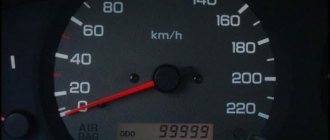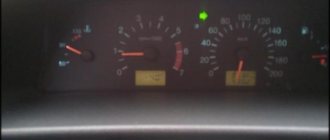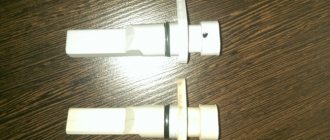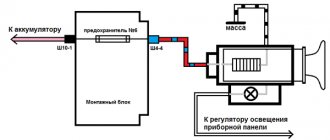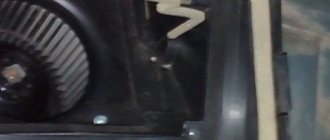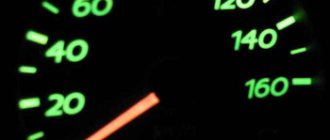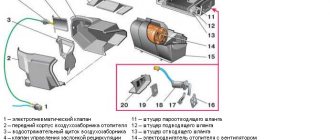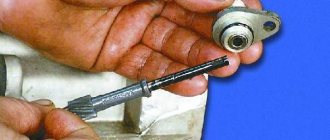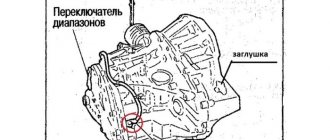VAZ tachometer connection diagram
The first car from the Zhiguli family equipped with a tachometer was the VAZ 2103. Neither 2101 nor 2102 had such a device. The tachometer is used to measure the crankshaft speed. It is a revolution counter, showing their number by deflecting the scale needle to a certain angle. The tachometer is also indispensable when setting up the carburetor - its indicators are taken into account when adjusting the idle speed and the quality of the fuel mixture.
VAZ-2106 tachometer connection diagram
The “Sixes” were equipped with a tachometer model TX-193. This tachometer consists of:
- plastic cylindrical body with glass holder;
- a scale divided into zones of safe and dangerous modes;
- backlight lamps;
- a milliammeter with an arrow attached to its shaft;
- electronic printed circuit board.
The principle of its operation is based on measuring the number of electric current pulses in the primary (low-voltage) circuit of the car’s ignition system. In the VAZ 2106 engine, for one revolution of the distributor shaft, corresponding to two rotations of the crankshaft, the contacts in the breaker close and open exactly four times. These pulses are removed by the device from the final terminal of the primary winding of the ignition coil. Passing through the parts of the electronic board, their shape is converted from sinusoidal to rectangular, having a constant amplitude. From the board, the current flows to the winding of the milliammeter, where, depending on the pulse repetition rate, it increases or decreases. The arrow of the device reacts precisely to these changes. The greater the current, the more the arrow deviates to the right and vice versa.
Connecting a tachometer in carburetor VAZ 2106
Electric circuit of the speed counter of the carburetor “six”
In a contactless ignition system, the tachometer is connected not to the coil, but to the switch
Connecting a tachometer in injection VAZs
It should be taken into account that the colors of the wires and their purpose may differ depending on the manufacturer of the device, but for the standard “TX-193” device, which is usually used in “sixes”, the diagram is as follows:
- A white cable is required to connect the backlight.
- The red wire is connected to the ignition switch, a fuse is used for this, this cable supplies power when the ignition is activated.
- A white cable with a black break is required for connection to the car body.
- The brown wire connects to the K+ terminal on the coil.
- The black wire is connected to the charging current indicator relay. The latter, in turn, is installed on the right in the engine compartment.
- The gray-black cable is required to connect to the engine fluid pressure regulator installed to the left of the engine.
Examination
It is better to test the component components of the engine speed counting system in order of priority. This will help to quickly identify the malfunction and conduct an additional examination of the condition of each element.
Before checking the electrical circuit and its parts, you should make sure that the fuel injection system is working. The serviceability of the gas distribution mechanism also affects the performance of the tachometer. Only after checking these components can we assume that the tachometer circuit is not working.
This device is located near the machine's generator pulley. You can check its operation using a multimeter. To do this you need:
- Set the multimeter to resistance measurement mode.
- Disconnect the sensor power supply connector.
- Connect the red control probe of the tester to terminal “1”.
- Connect the black measuring probe to terminal “2”.
- Crank the engine with the starter.
When open, the device will show a resistance of up to 550–750 Ohms. If the tester does not measure the operating resistance of the sensor, you will have to dismantle it. To do this, you will need to unscrew one nut that secures the element. Very often, metal shavings stick to the magnetic sensor and interfere with the opening. If chips have accumulated on the rod, they must be removed, the body must be cleaned with a solvent and the resistance measurement must be repeated.
After checking the DPKV, you need to check the integrity of the wiring that powers the sensor and transmits pulse signals to the control unit. It is necessary to inspect the wires and check the integrity of the insulation. You will also have to clean both halves of the connecting plug with solvent.
Ignition module
This device is most often prone to breakdowns. This happens due to a short circuit to ground. The check is carried out with the engine running. During operation of the power unit, it is necessary to remove the power wires from the spark plugs one by one. After this, you need to direct the end of each wire towards the engine block, but without touching it. A spark should appear from the end of each wire. It should be blue. If the spark is yellow or there is no spark at all, the module and wires will have to be ringed.
The wires can be tested with a multimeter only to check the integrity of the cores. It is not possible to determine an insulation breakdown in this way. It is better to replace all suspicious elements with new ones. Often, owners replace standard high-voltage wires with modern silicone analogues; this should not be done. The electrical resistance of such wires is very high; it does not allow the spark of the required discharge to pass through. It is also worth carefully inspecting the caps that are placed on the candles. Parts with poor contact or external defects must be replaced.
Before checking the module, you need to test the wiring that powers this device. To do this, you need to disconnect the plug. Next, you will need a multimeter in DC voltage measurement mode.
- Connect the red measuring probe to terminal “1”.
- Connect the black measuring probe to terminal “3”.
- Turn on the ignition.
The tester should show a voltage of 12 volts or equal to the battery voltage. If there is no voltage at all, then you need to check the integrity of the fuse responsible for the ignition module. It is located under the trim on the right side under the instrument panel, the very first one on the hood side. Has a rating of 15 amps.
If voltage is supplied to the module, then it is necessary to check each coil of this assembly.
- The primary windings are checked for the presence of operating resistance. To do this, you need to switch the multimeter to resistance measurement mode. Next, you need to connect the red test lead to pin 1 of the power wire going to the first cylinder, and the black test lead to pin 4 of the cylinder. The operating resistance must be at least 0.5 Ohm.
- The second primary winding is checked in the same way, only at terminals 2 and 3.
Next, the secondary winding is checked. To do this you need:
- Connect the red measuring probe to terminal “1” on the module socket.
- Connect the black measuring probe to terminal “3”.
- The operating resistance should be 0.5 Ohm.
The third check is the most important. It is carried out to test for the presence of a short circuit.
- The red test probe is connected to the module's connecting socket.
- The black test probe is connected to the device body.
- A working module should not show resistance. If it is, even the most minimal, then the device will have to be replaced.
If the module has fully passed the test, it must be inspected. Any cracks in the housing, even the most minor ones, can create a ground fault during operation in wet weather. Such deformations cannot be eliminated; the unit will have to be replaced with a similar one. You also need to clean the sockets of the high-voltage wires going to the spark plugs.
Fuse
Very often the tachometer does not work due to a fuse problem. If the instrument panel does not work at all and there is no backlight, then we can assume that fuse “F9” has failed. It must be removed and checked using a tester. The multimeter is switched to continuity mode, both test leads are connected to the fuse contacts. The absence of a buzzer will indicate a malfunction of the protective element. It will have to be replaced with a similar device rated 10 amps.
You also need to check the fuse socket. Clean any dirt, oxidation, carbon deposits with alcohol. Bend the contacts with a screwdriver.
Next, the electrical voltage coming to the fuse is checked. This requires:
- Switch the multimeter to voltmeter mode to measure DC voltage.
- Connect the red test lead to the fuse output.
- Connect the black test lead to ground.
- Turn on the ignition.
The voltmeter should show a voltage identical to the battery charge.
Receiver block
If the previously described checks did not bring results, and all the elements are in good order, then you need to test the tachometer itself. A simple check is to reset the odometer. After resetting, you need to hold down the odometer button and turn on the ignition. The tachometer and speedometer needles should deviate to the maximum position and return back. If the tachometer does not respond to the voltage supply, you will have to dismantle the dashboard and remove the device. To do this, you need to unscrew the 4 screws of the cladding in front of the protective glass and dismantle it. Next, remove 4 more screws holding the instrument panel itself. After dismantling, you need to pull the block towards you.
Electrical power is supplied to the tachometer through a yellow (sometimes white) connector. “+” terminal number “8” is the very first in the bottom row. To check the power supply, you must:
- Switch the tester to DC voltage measurement mode.
- Disconnect the plug.
- Connect the red probe to pin “8” of the incoming power cable.
- Connect the black probe to ground.
With the ignition on, the voltmeter should show a voltage of up to 12 volts. If there are no readings, then you should check the ignition switch terminal.
Next, terminal “2” of the receiver unit itself is checked. She is the very first one in the top row. Responsible for power supply with pulsed current. To check it, you need to run a test wire from the “+” terminal of the battery. The second end of the wire must be abruptly connected to terminal “2” several times. The tachometer needle should respond to the simulated impulses by deflecting at a certain angle. If there is no deviation, then the reason lies in the receiver itself.
It needs to be inspected visually for oxidation and broken tracks. A big problem with such receivers is microcracks in the solder. You should carefully inspect all connections and eliminate any defects found. Then repeat the check again.
If the receiver unit is working properly, power is supplied from the ignition and there is a reaction from the arrow to simulated pulses, then the problem lies in the ground terminal. It is the very first one, located in the corner between the rows of plugs. Necessary:
- Set the tester to voltmeter mode.
- Connect the red test probe to terminal “2” of the incoming cable plug.
- Connect the black probe to terminal “1” of the same plug.
- Turn on the ignition.
If there are no readings, then it is worth connecting the black control probe to ground in another place. The presence of data will indicate a break in the ground line. It can be pulled through using a jumper and pre-fixed with a bolted connection in the engine compartment.
Connection diagram for tachometer VAZ-2108 and 2109
Let us immediately note that the fuel supply system – injector or carburetor – does not play a special role here. As you know, currently the most common are cars with the following engine types: gasoline or diesel. Depending on this, the tachometer is selected, unless, of course, it comes in the stock version. The thing is that on gasoline engines the tachometer reads data from the ignition coil, or rather, the impulses that arise here. However, the design of diesel power plants does not provide for this unit. Accordingly, here the tachometer reads pulses not from the ignition coil (for lack of one), but from the generator.
The first two wires (12-volt and Signal) are to contacts “B” and “K” of the ignition coil, respectively. All that remains is to secure the mass in any convenient place.
VAZ-2110 tachometer connection diagram
- tachometer VAZ;
- trip computer;
- ECM;
- crankshaft position sensor;
- ignition module.
Tachometer VAZ 2110 - with four outputs: if it is on a car with injection, it is connected not to the ignition (input 2), but to the ECM controller with an additional output provided for this (input 1) - and in this case it reads the number of revolution pulses directly from the controller. It receives a signal about the position of the shaft.
What else is the reason for the speedometer not working?
However, often the reason for the speedometer malfunction lies elsewhere:
- Oil and dust get into the speed sensor, which is located in the engine compartment under the hood of the car.
The malfunction is eliminated after removing dirt and oil by washing the sensor. If the DS fails and needs to be replaced, any car owner can perform this simple operation independently.
The replacement sequence is as follows:
- place the machine on a flat horizontal surface;
- open the hood and find the speed sensor on the gearbox;
- by pressing the latch bracket, the plug is disconnected from the DS:
- to remove the sensor, use a 22 mm wrench, turning it counterclockwise;
- The new part is installed by screwing it in by hand. The use of a wrench is not recommended, as you may miscalculate the rotation and break the thread;
- install the connector, as evidenced by the click of the fixed part.
The driver should buy a new DS with similar markings. Otherwise, the speedometer needle will display incorrect readings.
- For some unknown reason, the VAZ 2110 speedometer stopped working. First of all, you need to check the most accessible elements associated with the speedometer. Since the car compartments are not ideally clean, dirt and moisture can damage any part, including wires and contacts.
Under the influence of moisture and dirt, wires and contacts can oxidize. Eliminating this cause is simple: the contacts must be removed, cleaned of oxidized deposits, wiped dry and reinstalled.
It is also necessary to check the integrity of the wires. Externally good wires may have broken sections of cores inside. Checking the serviceability of the wires involves ringing their surface with a tester.
During operation, the splines and elements that rotate the speedometer cable may be damaged. Such a defect may impair the operation of the instrument panel. You can verify its serviceability by testing it.
- The third, very important defect is the malfunction of the speed sensor. This device is located on the gearbox, adjacent to the exhaust manifold. This factor leads to heating and chafing of the DC wires.
The reasons for the sensor being out of working condition, the fault can be determined at the service center. The technician will perform this procedure in the presence of the car owner.
To troubleshoot the problem yourself, you should do the following:
- The speed sensor must be removed by unscrewing it from the gearbox;
- connect the DC wire to a screwdriver or drill, set the rotation counterclockwise;
- turn on the ignition.
The movement of the arrow indicates that the sensor is working properly. The weak link is most likely located in the vehicle's transmission. It is difficult for a driver without experience to cope with this task. In this case, the problem must be solved by car service specialists.
If the speedometer needle on a VAZ 2110 does not work, the speed sensor must be replaced.
The speedometer on a VAZ 2110 with an injector is an important element of any car, not excluding the “top ten”. VAZ 2110 drivers even with little experience can check and find the source of the malfunction of this device. However, if you cannot determine the source of the speedometer problems, you need to draw the attention of technical service specialists to this problem.
About the DPKV tachometer sensor
The tachometer has a sensor (crankshaft position sensor - DPKV). This device serves not only to count crankshaft revolutions, but also to determine its position at a certain moment, which is necessary for the electronic control unit to ensure proper operation of the power unit. When a metal object passes near the sensor core, an electrical impulse is generated in it, which is transmitted to the electronic engine control unit. The role of such an object in the power unit of a car is played by the crankshaft gear.
Why does the VAZ tachometer jump?
It often happens that the needle starts to twitch. If the car is fuel-injected, then troubleshooting involves connecting a diagnostic scanner and checking the engine systems. Jumps in the TX-193 needle in most cases are also a symptom of malfunctions associated with its electrical circuit. The reasons for this behavior of the device may be:
- lack of good contact at the negative terminal of the battery;
- oxidation or burning of the brown wire on the ignition coil;
- burning or wear of the contacts of the ignition distributor cap or slider;
- wear of the distributor shaft bearing;
- shorting the red wire powering the device to vehicle ground;
- malfunction of the crankshaft position sensor (for injection engines).
Speedometer Troubleshooting Options
Before troubleshooting, you need to find out exactly the reason why the speedometer on the VAZ 2112 does not work. There is a reliable and simple method for this. The check begins with the speed sensor and, in search of a breakdown, moves towards the speedometer.
You should make sure that all wires and devices are in good working order. To determine the presence of a signal, you can use a lamp to which wires are soldered. It can be easily connected to the vehicle's on-board network.
Check procedure:
- The first wire is connected to the negative terminal of the battery.
- The second simulates impulses, trying to touch contact “A” with a certain frequency.
- If the speedometer reacts - the arrow turns at a small angle - then this part of the electrical circuit is working.
- By touching the contacts all the way from the block to the device, you can determine where the break is located.
If the tachometer on a VAZ does not work
Usually, the lack of response from the arrow is due to a broken contact in the connectors of the main wires of its connection, or damage to the wiring of the circuit. The first step is:
- Inspect the fastening of the conductor in brown insulation to terminal “K” on the ignition coil. If you detect poor contact, traces of oxidation, burning of a wire or terminal, fix the problem by cleaning the problem areas, treating them with anti-corrosion liquid, and tightening the fastening nut.
- Check the reliability of the connection of the black and white wire to the vehicle ground. If contact is broken, clean the wire and the surface to which it is attached.
- Using a tester, determine whether voltage is supplied to the red wire when the ignition is on. If there is no voltage, check the serviceability of fuse F-9, which is responsible for the integrity of the instrument panel circuit, as well as the condition of the ignition switch contacts.
- Disassemble the instrument panel and check the connections of the contacts in the tachometer wiring harness block. “Ring” all the wires going to the device with a tester.
Malfunctions on Priora
If the speedometer on a Priora stops working, the first thing you need to do is temporarily remove the terminals from the battery.
Did not help? – Then look for a fault in the device circuit. First, check the integrity of the instrument panel fuse.
If it burns out, replace it (but first make sure that all contact connections are intact).
If the problem persists or the fuse is normal, check all the wires on the path from the speed sensor to the instrument panel. This can be done using a multimeter.
If there are no complaints about the wiring, check the motion sensor with a special scanner. If there are malfunctions, the element must be replaced.
The serviceability of the motion sensor can be determined by the behavior of the odometer. If the speedometer does not work, but the odometer counts kilometers, then the sensor is working, and the breakdown must be looked for elsewhere.
For example, problems may be in the soldering on the dashboard circuit board or, even worse, in the gearbox. But this can only be found out at a service station with the help of a qualified technician.
The tachometer does not work on the VAZ 2110 injector reasons
REASONS FOR A NON-WORKING TACHOMETER
The tachometer in a car is used to indicate the number of revolutions of the engine crankshaft. Let's look at why the tachometer doesn't work and how to find and eliminate the cause of the breakdown. We will definitely dwell on the device and principle of operation, which will help to find out why the tachometer stopped working, the needle twitches or behaves inappropriately.
CLASSIFICATION BY OPERATING PRINCIPLE
- Mechanical or electromechanical tachometers with direct drive. The revolutions are transmitted to the dial indicator through a flexible shaft, which, through a worm gear, receives rotation directly from the crankshaft or one of the transmission shafts. The operating principle of the indicator is based on the phenomenon of eddy current induction. The operation and design of a magnetic tachometer are extremely similar to the operating principle of a car speedometer. In modern cars, a similar tachometer design is not used.
- Electric machine. A distinctive feature is the connection to a generator. It is used primarily on diesel engines, but for the purpose of unification, a device of this type can also be used on gasoline engines.
- Electronic. The signal can be taken either from the ignition system or directly from the computer. Installed on gasoline and diesel internal combustion engines.
DEVICE AND PRINCIPLE OF OPERATION
Main components of electric machine and electronic tachometers:
- measuring unit, or signal converter. It can be based on elements of analog circuitry or built using special microcircuits;
- display unit with analogue or digital display of the number of revolutions;
- auxiliary elements.
The operation of electronic tachometers is based on the conversion of individual signals or pulses captured from the computer, ignition system or generator into a signal “understandable” for the display unit.
CONNECTION DIAGRAM
When looking for the reason why the tachometer does not work, it is first of all important to understand the connection diagram and the type of signal. There are 3 typical connection schemes:
- to a contactless ignition system (the tachometer wire is connected to the primary circuit of the ignition coil). The operating principle is based on measuring the frequency of voltage surges in the primary circuit of the ignition system. Calculating the ignition angle is impossible without focusing on the number of crankshaft revolutions, therefore the sparking frequency directly depends on the crankshaft rotation speed. On 4-cylinder internal combustion engines, a full revolution of the crankshaft corresponds to 2 voltage pulses in the primary circuit. Accordingly, the higher the crankshaft rotation speed, the greater the frequency of voltage surges;
- connection to the contact ignition system. The operating principle and connection diagram are similar to the BSZ, but the design of the measuring unit will differ depending on the voltage of the input circuit;
- connection to the engine ECU. The principle of operation is still based on recording voltage pulses in the primary circuit of the ignition system, but the signal to the tachometer comes from the engine control unit;
- connection to the generator (the tachometer signal contact is connected to terminal W of the generator). The rotation of the generator pulley is carried out by a belt drive from the crankshaft, so the rotation speed of the generator rotor will always be proportional to the crankshaft speed. The change in the number of revolutions of the crankshaft can be calculated by constantly measuring the amount of EMF generated on the winding. By its operating principle, an electric machine tachometer resembles a conventional voltmeter.
General faults
During operation, have you noticed that the needle in the car’s speedometer is inactive (at any speed)?
The first thing to do is to check the tightness of the fastening nut of the speedometer tips, as well as its drive.
If, after checking, no comments are found or the work performed does not bring the desired effect, then there is a risk of damage to the speed indicator drive or breakage of the flexible shaft.
In the latter case, the part will have to be changed. At the same time, do not forget to apply high-quality lubricant to the area near the seal (Litol-24 may be suitable for these purposes).
Once the work is done, thread the shaft through the seal - this will help distribute the lubricant over the surface of the cable.
The appearance of a knocking sound while driving may indicate a malfunction of the speedometer flexible shaft.
The reasons for this phenomenon include large bends in the cable under the instrument panel, dents, and so on. Make sure that the radii of the roundings do not exceed 10 centimeters.
Sometimes while driving you may notice a “growling” sound, approximately in the front of the car. The reason may be the speedometer cable, which often makes noise in the absence of proper lubrication.
This is one of the most important car devices. Its task is to show the number of revolutions of the engine crankshaft at a certain point in time.
A tachometer breakdown is not so critical. But in the long term, it is precisely this that can cause engine malfunction and new costs for the car owner.
So how to deal with a breakdown, and what could be the main causes of the malfunction?
In fact, there are not many of them. In the case of an electronic tachometer, the LED screen of the device most often fails. Repairs in this case are problematic - it is better to replace the display.
Nissan Qashqai tachometer contacts.
Malfunctions of the tachometer are often caused by poor contact quality or faulty wiring (in this case, impulses from the engine to the device may not arrive at all).
To eliminate such troubles, you need to carefully inspect all wires for cracks and breaks. If you find a crack, simply solder it, and if a break is detected, replace part of the wiring.
The cause of a tachometer malfunction may be a failure of the engine speed sensor.
It is not difficult to diagnose the problem - the tachometer needle begins to “jump” in different directions. There is only one way to return the tachometer to “life” - by replacing this element.
Please note that the above malfunctions and methods for eliminating them are of a general nature. Each car model may have its own nuances, and we will talk about some of them in more detail.
VAZ tachometer connection diagram
The first car from the Zhiguli family equipped with a tachometer was the VAZ 2103. Neither 2101 nor 2102 had such a device. The tachometer is used to measure the crankshaft speed. It is a revolution counter, showing their number by deflecting the scale needle to a certain angle. The tachometer is also indispensable when setting up the carburetor - its indicators are taken into account when adjusting the idle speed and the quality of the fuel mixture.
VAZ-2106 tachometer connection diagram
The “Sixes” were equipped with a tachometer model TX-193. This tachometer consists of:
- plastic cylindrical body with glass holder;
- a scale divided into zones of safe and dangerous modes;
- backlight lamps;
- a milliammeter with an arrow attached to its shaft;
- electronic printed circuit board.
The principle of its operation is based on measuring the number of electric current pulses in the primary (low-voltage) circuit of the car’s ignition system. In the VAZ 2106 engine, for one revolution of the distributor shaft, corresponding to two rotations of the crankshaft, the contacts in the breaker close and open exactly four times. These pulses are removed by the device from the final terminal of the primary winding of the ignition coil. Passing through the parts of the electronic board, their shape is converted from sinusoidal to rectangular, having a constant amplitude. From the board, the current flows to the winding of the milliammeter, where, depending on the pulse repetition rate, it increases or decreases. The arrow of the device reacts precisely to these changes. The greater the current, the more the arrow deviates to the right and vice versa.
Connecting a tachometer in carburetor VAZ 2106
Electric circuit of the speed counter of the carburetor “six”
In a contactless ignition system, the tachometer is connected not to the coil, but to the switch
Connecting a tachometer in injection VAZs
It should be taken into account that the colors of the wires and their purpose may differ depending on the manufacturer of the device, but for the standard “TX-193” device, which is usually used in “sixes”, the diagram is as follows:
- A white cable is required to connect the backlight.
- The red wire is connected to the ignition switch, a fuse is used for this, this cable supplies power when the ignition is activated.
- A white cable with a black break is required for connection to the car body.
- The brown wire connects to the K+ terminal on the coil.
- The black wire is connected to the charging current indicator relay. The latter, in turn, is installed on the right in the engine compartment.
- The gray-black cable is required to connect to the engine fluid pressure regulator installed to the left of the engine.
Connection diagram for tachometer VAZ-2108 and 2109
Let us immediately note that the fuel supply system – injector or carburetor – does not play a special role here. As you know, currently the most common are cars with the following engine types: gasoline or diesel. Depending on this, the tachometer is selected, unless, of course, it comes in the stock version. The thing is that on gasoline engines the tachometer reads data from the ignition coil, or rather, the impulses that arise here. However, the design of diesel power plants does not provide for this unit. Accordingly, here the tachometer reads pulses not from the ignition coil (for lack of one), but from the generator.
The first two wires (12-volt and Signal) are to contacts “B” and “K” of the ignition coil, respectively. All that remains is to secure the mass in any convenient place.
Expert recommendations
Some expert recommendations regarding diagnostics and repair of speakers:
- Diagnosis of the cause of unit failure should begin with a visual inspection of the speed sensor, as well as the wiring connected to it. As practice shows, the reason often lies in a broken wiring, in particular, in the place next to the plug.
- If the controller is covered with dust or oil, you need to dismantle it and wipe it thoroughly. Then you can put the sensor in place and try to check the performance of the speaker. There is a possibility that after these steps the speaker will operate normally.
- Under no circumstances should you drive with a non-working speaker, so if problems are found in its operation and you cannot check it yourself, you need to seek help from a specialist.
VAZ-2110 tachometer connection diagram
- tachometer VAZ;
- trip computer;
- ECM;
- crankshaft position sensor;
- ignition module.
Tachometer VAZ 2110 - with four outputs: if it is on a car with injection, it is connected not to the ignition (input 2), but to the ECM controller with an additional output provided for this (input 1) - and in this case it reads the number of revolution pulses directly from the controller. It receives a signal about the position of the shaft.
About the DPKV tachometer sensor
The tachometer has a sensor (crankshaft position sensor - DPKV). This device serves not only to count crankshaft revolutions, but also to determine its position at a certain moment, which is necessary for the electronic control unit to ensure proper operation of the power unit. When a metal object passes near the sensor core, an electrical impulse is generated in it, which is transmitted to the electronic engine control unit. The role of such an object in the power unit of a car is played by the crankshaft gear.
Device
The tachometer makes it possible to switch to another speed in time so that the engine operates in economical mode. A novice driver can focus on the position of the arrow. If it approaches the red zone, then you need to shift to a higher gear. In addition, the device is used to adjust the operation of the power unit at idle and control the crankshaft speed while driving (author of the video - Avto-Blogger.ru).
Analog tachometers are reliable and simple measuring instruments.
Their design includes the following elements:
- pointer arrow;
- graduated scale;
- an electromagnetic coil with a shielded winding;
- cable for transmitting information from the crankshaft.
The operation of the device is based on the electronic principle. The signal from the crankshaft is transmitted through wires to a microcircuit, thanks to which the needle moves along the dial. Information can be taken directly from the shaft, from the generator or from other power take-off shafts. In this case, the original signal is converted with a certain coefficient.
Why does the VAZ tachometer jump?
It often happens that the needle starts to twitch. If the car is fuel-injected, then troubleshooting involves connecting a diagnostic scanner and checking the engine systems. Jumps in the TX-193 needle in most cases are also a symptom of malfunctions associated with its electrical circuit. The reasons for this behavior of the device may be:
- lack of good contact at the negative terminal of the battery;
- oxidation or burning of the brown wire on the ignition coil;
- burning or wear of the contacts of the ignition distributor cap or slider;
- wear of the distributor shaft bearing;
- shorting the red wire powering the device to vehicle ground;
- malfunction of the crankshaft position sensor (for injection engines).
A similar problem is solved by stripping the contacts, replacing the ignition distributor cap, slider, support bearing, restoring the integrity of the insulation of the device’s supply wire, and replacing the crankshaft sensor.
Another jump may be due to the inoperability of the capacitor located at the bottom of the breaker. The capacitor may be broken or its contact is very weak.
If the tachometer on a VAZ does not work
Usually, the lack of response from the arrow is due to a broken contact in the connectors of the main wires of its connection, or damage to the wiring of the circuit. The first step is:
- Inspect the fastening of the conductor in brown insulation to terminal “K” on the ignition coil. If you detect poor contact, traces of oxidation, burning of a wire or terminal, fix the problem by cleaning the problem areas, treating them with anti-corrosion liquid, and tightening the fastening nut.
- Check the reliability of the connection of the black and white wire to the vehicle ground. If contact is broken, clean the wire and the surface to which it is attached.
- Using a tester, determine whether voltage is supplied to the red wire when the ignition is on. If there is no voltage, check the serviceability of fuse F-9, which is responsible for the integrity of the instrument panel circuit, as well as the condition of the ignition switch contacts.
- Disassemble the instrument panel and check the connections of the contacts in the tachometer wiring harness block. “Ring” all the wires going to the device with a tester.
How to check the speed sensor
After examining the contacts and wires for oxidation, contamination, damage, if they are not found, then it is necessary to check the sensor itself. There are reliable methods for determining the performance of a device.
How to check the DS for functionality? The procedure for determining the health of the sensor can be carried out using a portable oscilloscope. It measures the signal coming from the device and displays it.
Using this method, you can visually determine not only that the sensor is faulty, but also try to determine the cause of the failure. You can get an idea of the nature of the signal using a conventional multimeter.
For diagnostics, it is necessary to connect the sensor wires to the measuring device, and rotate the device itself, holding the core. You can fix the sensor in the screwdriver sleeve. Then a rectangular image should appear on the oscilloscope screen. After one rotation, six pulses should be shown. This is what the signal from a working sensor looks like.
What the oscilloscope shows
If the speedometer on an injection-type VAZ 2110 does not work, and a signal is sent to the device, then the complaint is most likely to the speed sensor drive. If the edges of the shaft are mechanically damaged, then the functionality of the system can be restored only after replacing the DS.
Important! The DS test can be performed without dismantling the device. If you lift the front wheel with a jack, then by rotating it you can get the same effect as using a screwdriver.

